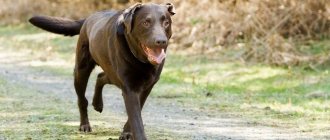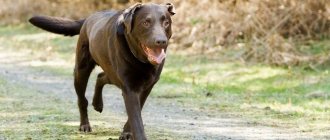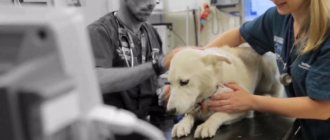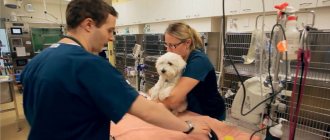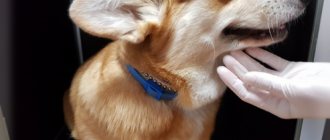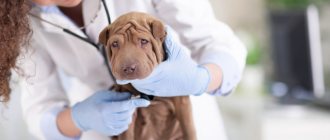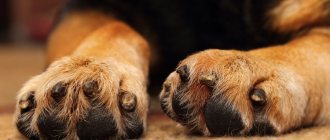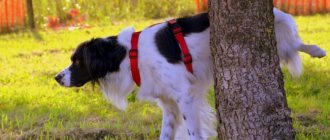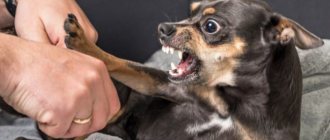What to do if you notice that your dog’s steps are disrupted and his gait has changed, turning into an asymmetrical movement? Lameness can be a symptom of several types of diseases and injuries, the accurate identification of which will require time and a visit to a veterinarian for timely treatment. Depending on the age of the animal, there may be various causes of lameness.
What can be considered lameness?
When a dog does not step on its hind paw, or leans on it, but in a very unusual way, or maybe even presses different paws, then the pet is considered to be limping.
Lameness is an unusual gait or posture of an animal. This is expressed by asymmetrical movement of the limbs due to dysfunction of the musculoskeletal system or the manifestation of other diseases of the body.
The dog is limping on its hind leg
If a dog is in pain, it is forced to take care of its paw - do not lean on it again and try to transfer the main weight to the other limb. This is how uneven gait occurs. Pain can be due to problems with joints, bones, muscles, tendons, bursae (periarticular bursa).
But sometimes lameness is a consequence of any abnormal development of the musculoskeletal system (for example, congenital or acquired deformities).
Valgus deformity of the pelvic limbs in a dog
It is important to understand that lameness is not a disease, but a symptom of some disease. The dog walks strangely because something happened to its paw or to its body as a whole. Therefore, initially you need to identify the main cause from hundreds of possible diseases and deal with it, because it is impossible to cure lameness.
Stages of recovery after a fracture
In order not to aggravate the situation and cause even more harm to the body, it is necessary to treat a fracture at home in accordance with a clear sequential scheme. It provides the following main recovery stages:
- The first stage begins immediately after the plaster is removed. At this time, the damaged area needs to be rubbed and massaged. Start exercises and massage almost immediately, but they should be light and not overload the still weak muscles. To stimulate recovery processes, local preparations in the form of a gel or cream can be applied to the area, but only as prescribed by a doctor.
- The second stage begins when the muscles, ligaments and other structures become a little stronger. To increase tone and motor activity, begin exercise therapy, physiotherapy, and perform more complex and intense exercises.
- The third stage is the final one. During this period, you can already increase your activity and go for long walks. The doctor can give a referral for treatment at a sanatorium or health center.
Why and how a dog limps on its hind leg
According to scientific data, lameness in dogs, in approximately 70% of cases, occurs in the hind limbs, of which 50% are diseases of the knee joints.
When a dog doesn't step on its back paw, an unusual gait occurs, and this is the most noticeable symptom that causes dog owners to go to the veterinary clinic.
Symptoms that owners most often pay attention to:
- the dog is limping on its hind leg without visible damage;
- restriction of limb movement while walking;
- the dog does not step on its hind paw - it periodically or constantly holds its paw up;
- unnatural position of the paw when the dog lies or sits;
- the dog often licks or bites a limb;
- periodic spontaneous screaming;
- trembling in the limbs;
- lameness due to acute pain and even in its absence;
- swelling of a joint or some other part of the limb;
- clicks are heard during movement, or a crunching sound (crepitus);
- lameness occurs only under certain conditions, for example, immediately after sleep or only after jumping over an obstacle;
- the presence of fluid (effusion) in the knee joint;
- the dog does not lean on one paw or the other;
- sometimes refusal to eat;
- muscle atrophy - it is clear that the muscle mass of one paw is different from the other.
Massage
Therapeutic massage after fractures involves the use of specific techniques:
- rubbing – active movements improve blood circulation and reduce pain;
- kneading – restore muscle tone, improve tendon mobility;
- stroking – light stroking movements relax muscles, improve microcirculation;
- effleurage - improves blood flow and increases muscle contractility.
The massage therapist selects a treatment course taking into account the characteristics of the injury and the exact location of the fracture. A course of therapeutic massage helps to avoid muscle atrophy and weakness, improve mobility, relieve swelling and pain.
How can you tell which leg a dog is limping on?
It happens that the owner sees that the dog is limping on its hind leg, but does not understand which one. If there is a limp on the right limb, most will think that the dog is lame on the left paw. The fact is that it is not easy to distinguish between lameness and seizure in a dog.
A fall is a forced transfer of weight to a healthy limb. If the right paw hurts, the animal will try to shift its weight to the left, that is, it will fall on the left paw. This is what owners perceive as lameness. Although in fact the dog is taking care of the right sore limb.
If your pet has short legs, then in order to keep up with you, he has to move very quickly. Therefore, it is very difficult to understand which paw he is limping on. In this case, it is better to make a video recording of the gait, and then watch it in slow motion.
If the dog is short-legged with long hair or very fluffy (for example, a Pekingese), then recognizing lameness becomes even more difficult. After all, the animal walks as if wearing a skirt, under which its short legs are hidden.
But the most difficult thing is when the dog is limping on different legs. This is called intermittent claudication (eosinophilic panosteitis). That is, at one moment there is lameness on one limb, at another - on another, at the third - on a third.
As you understand, without a veterinarian it is very difficult to understand which limb the dog is actually limping on. But, most importantly, you will not be able to understand on your own why your gait is impaired.
YES, WE NEED AN ORTHOPEDIST
External means
After the cast is removed, the patient may experience pain and swelling for a long time. To get rid of these unpleasant manifestations of injury, the doctor may prescribe ointments and gels that relieve discomfort. Such drugs have important effects:
- analgesic – relieves pain, improves motor abilities;
- anti-inflammatory – improves tissue condition, relieves inflammation, redness, swelling;
- muscle relaxant – promotes muscle relaxation, relieves excessive tone, improves the effect of painkillers;
- regenerating – stimulates restoration processes, activates metabolism in damaged tissues.
External medications have much less negative effects than oral medications. Therefore, many doctors prefer ointments and gels with local action.
"Pills for Lameness"
A “pill for lameness” purchased at a veterinary pharmacy will not cure, but will only blur the symptoms and lead to aggravation of the problem.
Veterinary pharmacies usually recommend purchasing a non-steroidal anti-inflammatory drug (NSAID). This drug suppresses pain and inflammation, reduces the production of inflammatory mediators, which further destroy bones and joints.
A pain reliever may also be recommended. Pain is the emotional coloring of some sensations that are perceived only in the head. Therefore, after using an anesthetic, the paw also continues to hurt, but the brain does not understand this, that is, the drug blocks the modulation of pain in the brain, therefore, the dog feels better.
When a pet does not step on its back paw, this does not mean that it has an orthopedic problem or injury.
Anti-inflammatory or painkillers can only temporarily dull the pain if the animal really has a problem with the limb. After using an NSAID or an anesthetic, the dog experiences the least discomfort - the paw practically does not hurt, the dog runs and jumps - the owner is happy. However, uncontrolled use of such drugs leads to bad consequences.
Three big disadvantages of uncontrolled anti-inflammatory and analgesic treatment:
- The lameness goes away, and that’s bad! Essentially, we are masking the symptoms. While the dog is limping, it at least somehow tries to protect its paw, so further mechanical destruction of the limb does not occur. As soon as you give your pet an anti-inflammatory or painkiller, she begins to lead an active lifestyle - running and jumping. However, the original problem does not go away. If the dog had a problem, for example, with a joint, then this pathology will remain so. As a result, the pet injures the limb even more, which leads to ligament ruptures, complete destruction of the joint, etc.
- As soon as you stop giving the drug, the lameness will immediately return.
- NSAIDs and painkillers have a number of side effects, so uncontrolled use of such drugs can even lead to bloody diarrhea. There is no need to add problems to either the dog or yourself.
So what should we do?
In 99% of cases, lameness does not go away on its own, because it is not a disease, but a symptom of some other pathology. The lucky 1% are dogs with certain anatomical features, or with a minor initial cause of the problem.
The longer the dog’s gait is impaired, the more the actual disease worsens, which ultimately leads not only to excruciating pain, but also to the fact that the pet will not be able to move independently.
Remember, when a dog is limping on its hind leg, it means that there is a disease involved that is hidden from our eyes. You can read dozens of articles on orthopedics and traumatology, but without using diagnostic equipment you still won’t be able to make a diagnosis on your own. And without a diagnosis there is no correct treatment.
The dog is uncomfortable, it hurts - in this case, you can’t wait for it to go away on its own. Be sure to show your pet to a veterinarian.
YES, WE NEED AN ORTHOPEDIST
Recovery in a supine position
For fractures of the extremities, recovery must begin when the patient is in a supine position and cannot stand. Only an early start of rehabilitation allows you to achieve maximum results. Otherwise, the muscles become inactive and weaken, causing the bones to heal incorrectly.
The complex of therapeutic exercises for a bedridden patient includes:
- shoulder lifts;
- lifting on the forearms;
- hand rotations;
- flexion, extension, pulling the healthy leg to the chest;
- contraction and relaxation of the muscles of the legs and arms;
- raising, abducting, bringing the injured limb to the body.
At the initial stage, these exercises should be performed under the supervision of a specialist and with his help. Over time, the patient will be able to perform gymnastics independently.
Why won't my dog step on its back paw, or how can a veterinarian help?
The most important reason you take your dog to the veterinarian is to get a diagnosis!
Now there are dozens of treatment regimens for any disease, but none of them will work if the diagnosis is initially made incorrectly. And in order for the doctor to understand what exactly is wrong with your dog, you need to conduct a full consultation. Be prepared for your veterinarian to ask you a lot of questions.
The reception will begin with communication
As soon as you enter the office with your dog, the doctor will immediately pay attention to the animal’s gait. But the appointment will begin with a survey (collecting an anamnesis) - he will clarify the breed, age, body weight of the animal, feeding and housing conditions.
General questions about your dog's health may reveal other medical conditions that are underlying causes of lameness.
The veterinarian will take into account the breed characteristics and age . This will help cross out some of the suspected diagnoses. For example, in an older dog, the doctor will not look for hip dysplasia or developmental abnormalities because the dog has already grown up. Conversely, there is no point in looking for degenerative osteoarthritis in a young puppy, since not enough time has passed for it to develop. Such patterns of diseases make it possible to filter out a whole list of diagnoses.
Body weight is very important, because excess weight increases the load on the joints, which accelerates their destruction. Also, fat is not just excess mass, it is tissue that actively produces pro-inflammatory hormones. In overweight animals, joints, skin, ears, kidneys, liver, heart are more likely to become inflamed, wounds heal worse, etc.
Overweight dog
The doctor will definitely ask what you feed your dog. According to scientific data, with an incorrectly formulated diet, an animal can not only experience obesity, but also phosphorus-calcium metabolism is disrupted , due to which calcium is washed out of bone structures (osteodystrophy). All this leads to brittle bones and frequent injuries.
At the appointment, you will have to remember whether there have been any previous injuries or surgeries.
Next, the veterinarian will ask about lameness:
- Which hind leg does a dog lame on? Is it always the same paw, or does the pet limp on one limb or the other?
- How long ago did the uneven gait appear? This is important to understand what course of the disease is acute or chronic.
- Under what circumstances does lameness appear - always, or only in the morning or after a walk? Lameness after resting usually indicates degenerative changes in the joints - these are problems that appear in most dogs in old age. Increased lameness after running or jumping usually indicates problems with muscles, tendons or ligaments.
A detailed survey will allow you to eliminate those diagnoses that do not fit the characteristics of your dog (i.e. differentiate diagnoses). Also, detailed information that you share with your veterinarian may indicate that the real cause of lameness is not hidden in the paw.
While you talk in detail about your dog, the veterinarian will definitely pay attention to how the animal stands, sits, lies, how it changes its position and transfers weight from paw to paw.
It is very important to take into account the positions of the dog's paws when it lies, sits, rises and walks.
The dog must be examined from ears to tail.
Don't be surprised if the dog's body temperature is measured, fur is examined, limbs are compared, and vertebrae are felt.
Sometimes during an examination, the doctor notices congenital deformation of the limbs , which occurs due to impaired bone growth. In this case, the dog limps mechanically not because it is in pain, but because its paws are of different lengths. In some cases, it is possible to correct the defect through surgery. Sometimes such a defect is possible after complex operations on the limb have already been performed (for example, after arthrodesis of a joint).
When a dog does not step on its hind paw, the first thing to look at is the paw pads . Calluses (corns), cuts, punctures, splinters, burns, frostbite, ingrown claws - these are the simplest and most understandable problems, but owners often do not notice them.
Claw embedded in paw pad
Help involves removing the foreign object, trimming the nails, treating the resulting wound, or possibly applying stitches.
04/13/18 What is first aid for wounds?
Often the cause of lameness can be dermatological problems . For example, furunculosis, sometimes interdigital dermatitis. In this case, the orthopedist will transfer the animal to another specialist, which is advisable.
Gait disturbances also occur with endocrinological diseases . For example, with Cushing's syndrome, there is loss of muscle mass, bone destruction, and lameness. Another disease of the endocrine system is hypothyroidism, in which dogs easily gain excess weight, which subsequently aggravates any pathologies.
But most often lameness is caused precisely because of pain. And this pain is not always in the paw itself. It happens that the reason lies in the discs of the spinal column . For example, severe pain in the lumbosacral region due to the fact that the vertebrae pinch (compression) the nerve endings (sciatic nerve root), causing cauda equina syndrome. In this case, the dog will also limp, as if its paw hurt.
I need to take a walk
If the veterinarian understands that the cause is truly orthopedic in nature, then further examination continues in motion.
At the veterinary clinic, the dog is stressed - she understands that something is clearly wrong, she is agitated and constrained. Sometimes the floor in the facility is slippery, so the pet walks on its claws, and this is no longer informative. Usually the room is cramped, there are different medicinal smells around, and there are other animals sitting in the corridor.
The best decision is to examine the dog’s gait in a spacious office or hallway, or even better, on the street in natural conditions. Outside the clinic, the dog habitually walks on the asphalt, because it is not slippery and not scary. It smells like the street outside, and the dog loosens up. Sometimes the doctor has to wait a few minutes so that the pet has time to sniff surrounding objects, new corners and paths. And only then can you see the natural gait and carefully examine the lameness.
Gait is often assessed at different paces: slow, fast, trot, canter if possible. The doctor can also lift the dog by the front or back legs - this way the diseased limb can be identified more quickly.
Thorough examination and orthopedic tests
When the doctor has realized which limb the dog is limping on, now he needs to determine the degree of lameness - to understand exactly where the paw hurts, down to the joint or muscle.
To understand this, the examination is carried out in the office: the animal is seated, placed on a table or laid on its side. The doctor carefully determines the range of motion in the joint, feels the paw - suddenly, in addition to pain, there is also swelling, crunching, etc. During the examination, the dog may try to bite or simply yelp - this allows you to understand where to look for the problem.
Sometimes the animal cannot be examined without anesthesia or sedation (shallow anesthesia)
After determining the location of the problem, the doctor may conduct special orthopedic tests and additional studies: x-rays, computed tomography, MRI or joint puncture.
Anterior cruciate ligament (ACL) tear test for drawer syndrome in a dog
And only after a thorough examination can the doctor make a diagnosis, determine the prognosis and prescribe treatment.
The most important purpose of visiting a veterinarian is to make a diagnosis!
YES, WE NEED AN ORTHOPEDIST
Nutrition
The recovery stage must be accompanied by a proper diet. During this period, the body needs more vitamins and nutrients, which must be obtained not only from food, but also from additional vitamin supplements.
During the period of active recovery, you need to saturate your diet with:
- protein (found in poultry, fish, meat);
- calcium and silicon (can be obtained from cottage cheese, oatmeal, beets, cheese, parsley, sesame);
- vitamins B, C and D (found in maximum quantities in fish oil, liver, bananas, legumes, citrus fruits).
While recovering from a fracture, you need to give up alcohol, sweet carbonated drinks, coffee, chocolate, fatty and salty foods.
Preventive actions
The following steps will help you avoid lameness:
- Proper animal care.
- Balanced diet.
- Regular examination of the limbs (at least once a week). Paws must be examined after going to the forest or mountains.
- In winter, small dogs should wear special shoes.
- Timely trimming of nails.
- Washing paws with soap after every walk, removing dirt from the spaces between the toes.
- Trimming the fur between the fingers.
- Tracking the degree and complexity of physical activity.
- Compliance with breed breeding rules (closely related unions are excluded, animals with hereditary diseases should not participate in breeding).
- When walking, avoid dangerous places (where there are a lot of stones, glass, branches, etc.).
- Minimize contact with other animals.
If lameness is detected in a pet, the problem should not be ignored under any circumstances. It is better to show the dog to a veterinarian and make sure that there is no cause for concern, or if a serious pathology is detected, start treatment on time.
Degenerative diseases of the spine
The normal functioning of the hind legs in dogs can be caused by diseases of the spine, which are degenerative in nature as a result of metabolic disorders in its tissues. Pathological changes occur in the structure of certain parts of the spinal column.
Discopathy is a disease of the intervertebral discs, accompanied by displacement and destruction of the intervertebral discs. As a result of discopathy, the altered disc substance penetrates the spinal canal and clamps the spinal cord or the spinal nerve roots emerging from the spinal cord.
Clinically, discopathy in dogs is manifested by repeated attacks of severe pain: the dog freezes in one position (usually with an elongated neck and hunched back), severe trembling appears, shortness of breath, the hind legs give way and weaken. If the compression of the spinal cord or spinal roots is insignificant, the dog’s owners note only the weakness of the hind limbs - the dog seems to be dragging them, tries to transfer the body weight mainly on the front paws, cannot jump onto the sofa (chair, armchair), cannot bend over to the bowl or semi.
Older dogs of large and giant dog breeds are most susceptible to discopathy: Great Danes, Rottweilers, German Shepherds, Doberman Pins and others. Clinical symptoms of the disease in these dog breeds usually progress slowly over several months or years.
Discopathy, which is often found in French bulldogs, is associated with the anatomical structure of the dog, when, during artificial selection, the spine of the bulldog became elongated, as a result of which it began to experience stronger loads, unlike the spine of dogs of other breeds. The distance between the vertebrae has become significantly greater than in ordinary dog breeds. Disc prolapse in a French Bulldog can occur not only during jumping, but possibly even during rest, when the dog lies quietly.
Spondylosis
When a dog has spondylosis, “local aging” of some vertebral segments occurs, causing the dog’s hind legs to fail.
Spondylosis as a disease progresses very slowly and therefore, at its early stage, it is practically not detected by veterinary specialists. With spondylosis, the outer fibers of the annulus fibrosus are initially damaged (the consistency of the nucleus pulposus is preserved), and then calcification of the anterior longitudinal ligament begins. Osteophytes develop, which, when examining the dog, especially on an x-ray, look like beak-shaped growths.
Osteocondritis of the spine
Osteochondrosis of the spine in dogs is considered by veterinary specialists to be the most severe form of the lesion. Osteochondrosis is based on degenerative processes in the intervertebral discs, often involving the vertebral bodies surrounding the intervertebral discs. At the same time, with osteochondrosis, changes occur in the ligamentous apparatus and intervertebral joints.
Etiology of osteochondrosis. The causes of osteochondrosis in dogs are:
- Spinal injuries.
- Rheumatoid lesions.
- Violation associated with a malnutrition of the disk (disk microcirculation is disrupted).
- Autoimmune diseases.
- Heredity.
